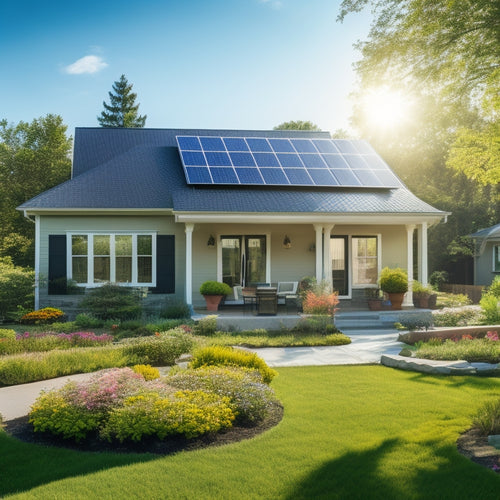
What Commercial Solar Financing Model Is Right for You
Share
When evaluating commercial solar financing models, it's crucial to assess your unique situation, including financial goals, risk tolerance, and creditworthiness. You'll want to examine cash purchase options, solar loans, power purchase agreements, operating leases, and other models. Each has its benefits, such as immediate savings, tax incentives, or flexible lease terms. To make an informed decision, weigh the pros and cons of each option against your project's specific needs. By understanding your financing requirements and exploring the available models, you'll be able to choose the best fit for your business and maximize your energy savings and returns - and uncover the subtleties of each model that will help you make the most of your investment.
Key Takeaways
- Evaluate your financial goals, risk tolerance, and creditworthiness to determine the best commercial solar financing model for your business.
- Consider cash purchase options for immediate savings, tax credits, and energy independence, but weigh against high upfront costs.
- Assess financing models like solar loans, PPAs, operating leases, and capital leases to find the best fit for your business needs and cash flow.
- Analyze lease term and payment options, such as fixed or variable payments, to ensure predictable expenses and maximize energy savings.
- Explore alternative financing solutions like PACE, community solar programs, crowdfunding, and hybrid models to find the most suitable option for your project.
Understanding Your Financing Needs
How do you determine your financing needs for a commercial solar project? You start by evaluating your financial goals, risk tolerance, and creditworthiness. A thorough risk analysis helps you identify potential roadblocks and opportunities. A credit assessment is also vital, as it affects the financing options available to you.
Next, contemplate the tax incentives that can benefit your project. These can greatly impact your cash flow and return expectations.
You should also review the project's scalability and long-term planning requirements. This includes understanding your energy consumption patterns and how they may change over time.
Regulatory compliance is another important factor to take into account. Make sure you understand the relevant laws and regulations governing commercial solar projects in your area.
Cash Purchase Options
You're considering a cash purchase option for your commercial solar project, which means you'll pay the full upfront cost of the system.
This approach offers an immediate savings benefit, as you'll start generating free electricity and reducing your energy expenses from day one.
Immediate Savings Benefit
When businesses opt for cash purchase options, they can immediately benefit from considerable savings on their energy expenses. This is because they're no longer tied to their utility company's fluctuating rates. You'll start saving money on your energy bills from day one, and those savings will add up over time.
Here are 4 key benefits you can expect:
-
Tax incentives: You'll be eligible for federal and state tax credits, which can considerably reduce your system's cost.
-
Energy independence: With your own solar system, you'll be less reliant on the grid, giving you more control over your energy expenses.
-
Long-term savings: Solar systems can last for 25 years or more, providing a long-term hedge against rising energy costs.
- Environmental impact: By going solar, you'll reduce your carbon footprint, contributing to a more sustainable future.
With a cash purchase, you'll also enjoy financial flexibility, a strong return on investment, and minimal maintenance costs.
Plus, you'll have peace of mind knowing your system's performance is backed by a manufacturer's warranty.
No Debt Obligation
By opting for a cash purchase, you eliminate the burden of debt obligation, freeing up your business's capital for more strategic investments.
With a cash purchase, you own the solar system outright, allowing you to reap the benefits of solar energy without any financial encumbrances.
This debt-free solution provides financial flexibility, enabling you to allocate resources more efficiently and make informed decisions about your business's future.
Solar Loan Financing Models
You'll find that solar loan financing models offer two primary options for commercial solar projects: fixed rate options, which provide predictability and stability, and variable rate structures, which can offer more flexibility but also come with interest rate risks.
These options differ notably regarding their financial implications and suitability for different businesses.
Fixed Rate Options
Fixed Rate Options provide a predictable and stable financing solution for commercial solar projects. With a fixed rate loan, you can lock in a set interest rate for the entire term of the loan, typically ranging from 5 to 20 years.
This financing model offers several benefits, including:
- Fixed rate stability: Your monthly payments remain the same, unaffected by market fluctuations.
- Predictable cash flow: You can budget accurately, knowing your energy costs won't change.
- No risk of rising interest rates: Your fixed rate protects you from potential rate hikes.
- Long-term cost savings: You can take advantage of lower energy costs over the loan term.
While fixed rate options offer advantages, they also come with some drawbacks. For instance, you may face penalties for early repayment, and fixed rates can be higher than variable rates.
Additionally, fixed rate comparisons may not always be favorable, and the lack of flexibility can be a disadvantage. However, for businesses seeking predictability and stability, fixed rate options can be an attractive choice for commercial solar projects.
Variable Rate Structures
As an alternative to fixed rate options, variable rate structures offer a distinct approach to commercial solar financing. With variable rates, your interest rate can fluctuate over the loan term, exposing you to market volatility. This structure is suitable for businesses that can tolerate interest rate fluctuations and are willing to take on more risk in pursuit of potentially lower interest rates.
When considering variable rate structures, it's important to conduct a thorough risk assessment and compare lenders to find the best option for your business. You'll need to carefully manage cash flow and engage in financial forecasting to guarantee you can absorb potential rate increases.
The benefits of variable rate structures include potentially lower interest rates, which can enhance investment returns and reduce tax implications. Additionally, this structure can provide more flexibility for project scalability and long-term sustainability.
However, it's vital to carefully evaluate the terms and conditions before committing to a variable rate loan to make sure it aligns with your business goals and risk tolerance.
Power Purchase Agreements
With the rise of commercial solar energy, Power Purchase Agreements (PPAs) have emerged as a popular financing model, allowing businesses to reap the benefits of solar power without shouldering the upfront costs.
In a PPA, you, as the business owner, agree to purchase electricity from a solar developer at a predetermined rate, usually lower than the grid rate. This model provides a clear benefit analysis, as you'll be able to predict your energy savings and reduce your carbon footprint.
When considering a PPA, you'll want to conduct a thorough risk assessment, examining factors such as:
-
Financial projections: Confirm the agreement aligns with your business's financial goals.
-
Contract terms: Understand the length and conditions of the contract.
-
Performance metrics: Monitor the system's energy output and adjust as needed.
- Tax incentives: Take advantage of available tax benefits to maximize your savings.
Operating Lease Options
In the solar financing environment, operating lease options have emerged as a viable alternative to traditional financing methods, offering businesses a way to employ the power of solar energy while minimizing upfront expenditures.
With an operating lease, you don't have to worry about the high upfront costs associated with purchasing a solar panel system. Instead, you'll make regular lease payments, typically over a 7-10 year term, allowing you to conserve capital for other business needs.
One of the key operating lease benefits is the ability to claim the lease payments as an operating expense on your balance sheet, which can provide significant tax advantages.
Additionally, the lessor (the company providing the lease) is typically responsible for maintenance and repairs, freeing up your resources for more critical business operations.
When deciding between a lease versus purchase, consider your company's financial situation, tax appetite, and energy goals. If you prioritize conserving capital and reducing upfront costs, an operating lease might be the right fit for you.
Capital Lease Financing
You'll find that capital lease financing offers flexible lease term options, allowing you to choose a lease duration that aligns with your business goals and cash flow requirements.
With a capital lease, you'll typically make monthly payments that are fixed and predictable, making it easier to budget and manage your expenses.
Lease Term Options
Tailor your capital lease financing to your business needs by selecting from a range of lease term options. This flexibility allows you to align your lease duration with your business goals and financial projections.
When evaluating lease term options, consider the following key factors:
-
Lease duration: Choose a term that matches your expected project lifespan or the period you expect to benefit from the solar installation.
-
Financial flexibility analysis: Assess your company's cash flow and determine how much you can afford to pay each month.
-
Depreciation benefits: Consider how the lease term will impact your ability to claim depreciation benefits on your solar installation.
- End-of-term options: Evaluate the conditions and costs associated with returning, purchasing, or extending the lease at the end of the term.
Monthly Payment Plans
Your capital lease financing agreement can be further customized with monthly payment plans that align with your business's unique financial situation. This allows you to manage your cash flow and optimize your energy savings. With a monthly payment plan, you'll have the flexibility to adjust your payments according to your business needs.
| Monthly Payment Plan | Benefits |
|---|---|
| Fixed Payments | Predictable expenses for easy budgeting |
| Variable Payments | Align payments with energy savings or seasonal fluctuations |
| Step-Up/Step-Down Payments | Increase/decrease payments over time to match changing business needs |
When evaluating monthly payment plans, conduct an affordability analysis to determine which plan best suits your business. Consider factors such as your current energy expenses, projected savings, and cash flow projections. By choosing a payment plan that aligns with your business goals, you can maximize your energy savings while maintaining payment flexibility. This way, you can focus on what matters most – growing your business.
Property Assessed Clean Energy
As local governments increasingly promote renewable energy initiatives, Property Assessed Clean Energy (PACE) financing has emerged as a viable solution for commercial property owners seeking to invest in solar energy.
With PACE financing, you can fund your solar project through a voluntary assessment on your property tax bill. This model allows you to benefit from the energy efficiency and long-term savings of solar energy without upfront costs.
Here are four key benefits of PACE financing:
-
Financing eligibility: PACE financing is available to commercial property owners who meet the financing eligibility requirements, which vary by state and local government.
-
Property benefits: PACE financing is tied to the property, not the owner, so you can sell your property without worrying about repayment.
-
Repayment structure: Repayment is spread over several years, typically 10-20 years, allowing you to realize long-term savings on your energy bills.
- Tax implications: PACE assessments are tax-deductible, reducing your tax liability and increasing your bottom line.
Community Solar Programs
One popular alternative to traditional on-site solar installations is Community Solar Programs, which enable multiple individuals or organizations to share the benefits of a single, off-site solar array. This model allows you to participate in solar energy generation without having to install panels on your own property.
Community solar benefits include reduced energy costs, access to renewable energy, and a lower carbon footprint.
However, community solar challenges exist, such as ensuring community solar accessibility and addressing community solar regulations that vary by state and locality.
Despite these challenges, community solar incentives, like tax credits and rebates, can make participation more attractive. You'll need to weigh these incentives against the community solar participation requirements, which may include minimum subscription periods or upfront fees.
Community solar ownership options also vary, with some programs allowing you to purchase a portion of the solar array or simply subscribe to the energy generated.
As you consider community solar, think about the community solar impact on your organization's energy costs and sustainability goals.
With careful planning and execution, community solar can be a viable and beneficial option for you.
Crowdfunding Solar Initiatives
Beyond community solar programs, another innovative approach to commercial solar financing is crowdfunding solar initiatives. You can raise capital for your solar project by pooling funds from a large number of individuals, typically through online platforms. This approach offers a unique opportunity to engage with your community and create a sense of ownership among investors.
Here are some benefits of crowdfunding solar initiatives:
-
Increased investor engagement: Crowdfunding allows you to connect with a large number of investors, creating a sense of community and ownership among them.
-
Reduced barriers to entry: Crowdfunding platforms often have lower minimum investment requirements, making it easier for individuals to invest in crowdfunded projects.
-
Diversified funding sources: By pooling funds from multiple investors, you can reduce your reliance on traditional funding sources.
- Enhanced project visibility: Crowdfunding campaigns can generate buzz and increase visibility for your project, potentially attracting more investors and customers.
Hybrid Financing Solutions
How can you combine the benefits of different financing models to create a customized solution for your commercial solar project? By exploring hybrid financing solutions, you can utilize the strengths of multiple approaches to achieve your project goals.
Hybrid models allow you to mix and match different financing structures, such as debt and equity, or tax equity and debt, to create a personalized solution that suits your unique needs.
Hybrid financing solutions offer financing flexibility, enabling you to adapt to changing project requirements or market conditions. For instance, you might combine a loan with a power purchase agreement (PPA) to balance upfront costs with long-term savings.
Alternatively, you could pair a tax equity investment with a construction loan to optimize tax benefits and reduce debt servicing costs.
Frequently Asked Questions
What Are the Tax Implications of Each Commercial Solar Financing Model?
When evaluating commercial solar financing models, you'll need to contemplate the tax implications, including tax credits, depreciation benefits, and how they impact investment returns and cash flow; understanding these implications will help you maximize your financial gains.
Can I Combine Different Financing Models for My Solar Project?
You can combine different financing strategies to optimize your project's customization, allowing you to tailor a financing plan that suits your specific needs, such as blending debt and equity financing or pairing PPAs with tax equity investments.
How Do I Determine the Best Financing Term for My Business?
A million options won't do - you need the perfect financing term! You'll want to contemplate your business's cash flow and the project's lifespan to determine the ideal term, ensuring a seamless integration with your operations and maximizing your ROI.
Are There Any Financing Options for Non-Profit Organizations?
You'll find that non-profit organizations can investigate specialized financing options, such as grant funding and solar loans with favorable terms, allowing you to utilize renewable energy while minimizing upfront costs.
Can I Use Existing Business Credit for Solar Financing?
You can utilize your existing business credit to secure solar loans, offering a convenient financing option for your commercial solar project, allowing you to tap into your established creditworthiness to power your sustainable energy goals.
Conclusion
You've traversed the vast terrain of commercial solar financing models, and now the possibilities seem endless! With a plethora of options at your fingertips, you're spoiled for choice. From cash purchases to crowdfunding, the perfect financing solution is out there, waiting to be released. So, take a deep breath, crunch the numbers, and pick the model that aligns with your business goals. The future of clean energy has never looked brighter – or more financially viable!
Related Posts
-

Solar Power Advantages for Rural Communities
Solar power presents numerous advantages for rural communities. You can greatly reduce energy costs, potentially by u...
-

How to Reduce Home Energy Bills
To reduce your home energy bills, start by investing in energy-efficient appliances and upgrading your insulation. Lo...
-

Affordable Solar Panels for Home Use
Affordable solar panels offer you a smart way to cut down on energy costs while promoting sustainability. With govern...


